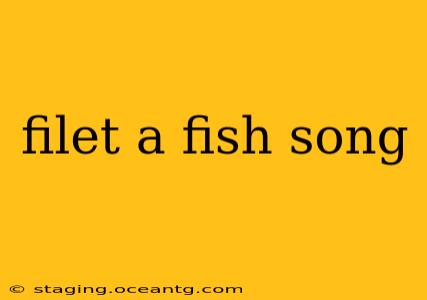Fillet a Fish: A Songwriter's Guide to Crafting a Catchy Tune
The phrase "fillet a fish" might not immediately conjure up images of chart-topping hits, but with the right approach, it can be the inspiration for a memorable and engaging song. This guide explores how to turn this seemingly mundane phrase into a compelling lyrical and musical concept. We'll delve into different musical styles, lyrical approaches, and storytelling techniques to help you create a truly unique song.
What Kind of Song Are We Aiming For?
The key to success lies in understanding what kind of song you envision. Are we talking upbeat pop, melancholic folk ballad, a quirky country tune, or something entirely different? The style you choose will heavily influence your melody, instrumentation, and lyrical approach.
Examples:
-
Upbeat Pop: A catchy, radio-friendly tune about the simple pleasures of preparing a delicious meal, perhaps with a focus on the fun and satisfying process of filleting the fish. Think bright melodies, driving rhythms, and lyrics that emphasize positivity and energy.
-
Melancholic Folk Ballad: A slower, more introspective song that uses the act of filleting a fish as a metaphor for a more complex emotional experience, perhaps dealing with loss, letting go, or facing difficult truths. Think fingerpicked acoustic guitar, a mournful melody, and evocative imagery in the lyrics.
-
Quirky Country: A humorous and slightly offbeat song that takes a lighthearted approach to the topic. Imagine a banjo, a playful melody, and lyrics that might exaggerate or satirize the process of filleting a fish.
What Story Will Your Song Tell?
The "fillet a fish" phrase offers several avenues for storytelling:
-
The Literal Approach: Focus on the actual steps involved in filleting a fish. This could be a fun, instructional song, perhaps targeting beginners. The lyrics could describe the tools needed, the different techniques, and the rewarding feeling of a perfectly filleted fish.
-
The Metaphorical Approach: Use "filleting a fish" as a metaphor for something else entirely. This allows for greater depth and creativity. For example, the fish could represent a problem needing to be solved, a relationship needing careful attention, or even a complex emotion that needs to be carefully dissected and understood.
-
The Narrative Approach: Create a story around the act of filleting a fish. This could involve a character who is learning to fillet a fish, someone who is using the act as a form of therapy, or even a mysterious event related to a particular fish.
How Can I Make It Catchy?
-
Memorable Melody: A strong and memorable melody is essential for any successful song. Experiment with different melodies and rhythms to find one that fits the chosen style and mood.
-
Compelling Lyrics: Craft lyrics that are interesting, evocative, and easy to understand. Use imagery, metaphors, and rhymes to make your lyrics stand out.
-
Strong Chorus: A powerful and memorable chorus is crucial for making your song stick in people's minds. The chorus should summarize the main idea or emotion of the song.
-
Instrumentation: Choose instruments that complement the chosen style and mood of your song. Experiment with different instrumental arrangements to find one that enhances the overall listening experience.
How to Write the Lyrics: A Step-by-Step Guide
-
Brainstorm: Generate ideas based on the different approaches outlined above (literal, metaphorical, narrative). What story or message do you want your song to convey?
-
Outline: Create a basic structure for your song (verse, chorus, bridge).
-
Write the Lyrics: Start writing verses, building up your story or conveying your message.
-
Refine and Edit: Revise your lyrics for clarity, flow, and impact. Experiment with rhymes and rhythms.
By thoughtfully considering these aspects, you can transform the seemingly simple phrase "fillet a fish" into a unique and memorable song. Let your creativity flow, experiment with different styles, and most importantly, have fun with the process!
